
A toadstool, more commonly known as a mushroom, is the name given to the spore-bearing reproductive part of a fungus. The word “mushroom” is most often used to talk about fungal bodies that are shaped like a tiny umbrella, consisting of a stem and a cap. Mushrooms are often confused for plants but they lack chlorophyll and do not perform photosynthesis.
There are over 10,000 known species of mushroom that range from the delicious and nutritious portobello mushroom (Agaricus bisporus) to the incredibly toxic and ominously named death cap (Amanita phalloides). Mushrooms are heterotrophs and mostly subsist on decaying organic matter. As such, they play a very important ecological role as nature’s waste removers.
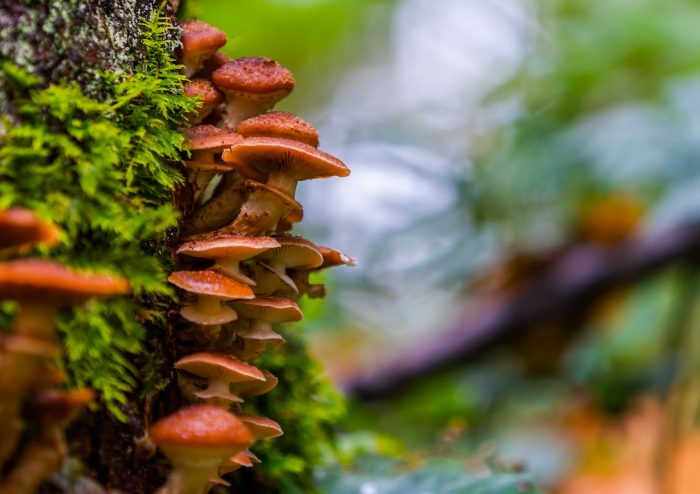
Credit: Pixabay CC0 1.0
Mushrooms have many uses ranging from cooking to medicine. Virtually every culture in the world eats mushrooms and mushroom cultivation is a major industry in many countries. Mushrooms with psychoactive properties have been used in native religious traditions all over the world and it is believed that mushrooms may have beneficial medicinal properties. The study of mushrooms (and fungi more generally) is called mycology.
Mushroom Morphology
Strictly speaking, the term “mushroom” refers to a particular part of a fungus; specifically, the fleshy reproductive body that sprouts above ground. The parts of a mushroom are called the stem (stipe), cap (pileus) and gills (lamellae). However, the term mushroom is often used to refer to fruiting bodies of fungi with different morphologies which may also have more specific names like “bolete”, “puffball”, “stinkhorn”, etc.
Despite a few shared features, mushroom morphology varies widely depending on the species. Many mushrooms take on the familiar umbrella shape but others appear more spherical (such as puffballs) or lack a stem entirely (earthstars and truffles).
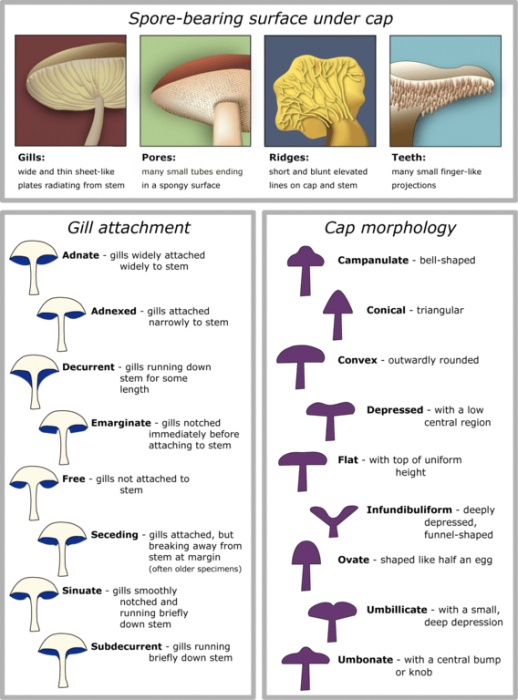
The different kinds of cap mushroom morphologies. Credit: Debivort CC-BY SA 3.0
All mushrooms form from a structure called the mycelium which is the main vegetative body of the fungus. The mycelium is formed out of small thread filaments called hyphae that weave their way through some substrate, be it organic or inorganic matter. When two compatible mycelia join it can result in the formation of a new fruiting body, a.k.a. a mushroom. Mushroom bodies are typically short-lived by the underlying mycelium can remain and continue growing for years.
All mushrooms also contain some kind of spore-producing surface. In the common cap shaped mushrooms, this surface is normally located on the underside of the cap and consists of the lamellae. The lamellae are covered by a thin layer of tissue called the hymenium which is where spores are produced. Most mushrooms are initially classified by the shape and function of the lamellae and hymenium.
After the spores are created, the mushroom releases them into the environment. The exact mechanism of dispersal differs from species to species. In some mushrooms, the spores fall off when ready while other mushrooms, such as puffballs, expel their spores when broken open. In this sense, mushroom bodies of fungi play a similar role as fruit in trees. They both are relatively short-lived structures that contain the reproductive material (spores/seeds) of their respective organisms.
Mushroom Lifecycle
When spores are released from a mature mushroom, they disperse and travel some distance before landing. Once rooted in a suitable substrate, the spores release hyphae and begin to form a mycelium. As the mycelium grows, it absorbs nutrients and water from the substrate. Eventually, when the mycelium meets the hyphae of another mycelium, the two reproduce and produce the mushroom that contains spores.
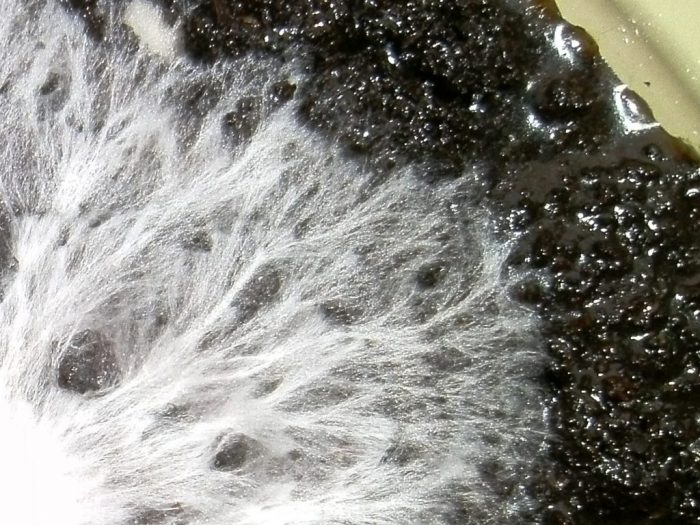
The mycelium of an oyster mushroom. Credit: T. Kellner via WikiCommons CC-BY SA 3.0
The small node that the mushroom body grows from is called the primordium. As it begins to grow, it shapes itself into a round egg-like structure called a button which is composed of threads of hyphae. The fruiting body emerges out of the button and expands while unfolding its cap. One the mushroom is mature, it releases its spores and the process begins anew.
While mushrooms are typically known for their quick growth (the phrase “to mushroom” means to expand rapidly) not all mushrooms grow quickly. Some take time to fully mature. But others can emerge and be gone within a 24 hour period.
Mushroom Metabolism
Mushrooms are commonly mistaken for plants but they do not contain any chlorophyll and do not perform photosynthesis. Like animals, mushrooms are heterotrophs meaning that they cannot produce their own food and must get it from external sources. Unlike animals, mushrooms do not eat by engulfing their food. Instead, the mycelium produces enzymes that break down the organic matter in the substrate. The monomers are then absorbed by the mycelium via diffusion and active transport. Fungi can feed very efficiently because the hyphae grow into their food source.
Ecological Roles Of Mushrooms
As Decomposers
Because mushrooms eat dead organic matter, they play an important role in every ecosystem. Mushrooms (and fungi more general) are an ecosystem’s principal decomposers and recycle the majority of organic materials.
Mushrooms cycle nutrients and convert them into a form that would be otherwise inaccessible. For example, plants require certain nutrients for growth which are rarely freely available in soil because they are bound up into insoluble compounds. Mushrooms break down these tough compounds and make the nutrients more readily accessible for plants. As a specific example, plants require nitrogen but nitrogen is normally locked into complex proteins that plants cannot absorb. Fungi break down the amino acids and free up the nitrogen to be taken in by plant roots.
Fungi also play a major role in the carbon cycle, the biogeochemical process that cycles carbon through the environment.
As A Food Source
Mushrooms also form an important part of food chains. Most aminals can eat some types of fungi and a handful of mammals, such as the caribou, rely almost entirely on fungi for their diet. Many insects and other invertebrates eat fungi, like banana slugs who are commonly seen feeding on mushroom bodies.
Symbiotic Relationships
Mushrooms and other fungi have formed numerous symbiotic relationships with plants. The most obvious example is lichen, which is a composite organism made out species of algae and cyanobacteria living in the hyphae of the mycelium. The fungi benefit from the carbon compounds photosynthesized by the algae and the algae benefits from the protection and water drawn in by the mycelium. In some way, one can see a lichen as a tiny self-contained ecosystem populated by various species of fungi, algae, and bacteria living together.
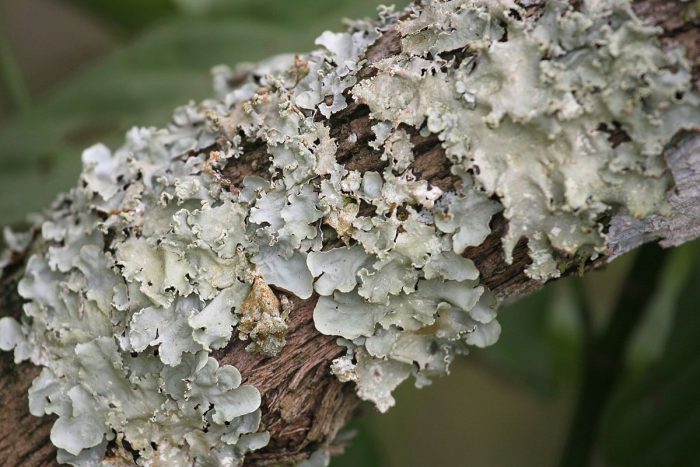
Lichen is a composite organism made out of bacteria, protists, and fungi. Credit: A. Proimos via WikiCommons CC-BY 2.0
Other kinds of fungi such as called mycorrhizal fungi form mutualist relationships with plants. These kinds of fungi associate with plant roots and give them vital nutrients while benefitting from the carbohydrates produced by the plant.
Mushrooms And Humans
As Food
Basically, every human culture in the world eats mushrooms. Mushrooms have a high carbohydrate count, low-fat content, and are a rich source of several vitamins such as vitamin D, riboflavin and niacin. Mushrooms are sometimes called the “meat” of vegetables due to their relatively high protein content, though they are neither meat nor a vegetable.
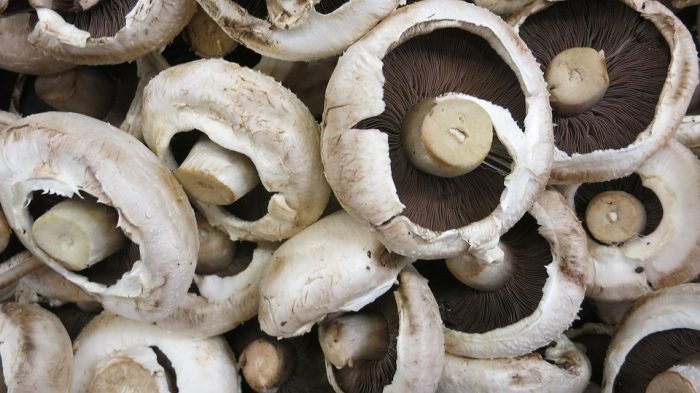
Portobello mushrooms are the most eaten mushroom in the world. Credit: Max Pixel CC0 1.0
The most common kind of mushroom eaten around the world is the portobello mushroom (Agaricus bisporus). Portobello mushrooms are cultivated in large quantities in over 70 countries. The largest producer of mushrooms in the world is China who produces over half of all cultivated mushrooms in the world.
As A Toxin
Several species of mushroom produce chemicals that are poisonous to most living organisms. The symptoms of mushroom poisoning range from mild gastrointestinal discomfort to severe organ failure and death. Ingestion of poisonous mushrooms is almost always the result of the misidentification of toxic species of mushrooms.
Mushrooms can be toxic because they produce metabolites that the body cannot filter and process properly. This is one reason why many types of mushroom poisoning cause kidney and liver failure. The majority of cases of fatal mushroom poisoning are caused by the death cap mushroom (Amanita phalloides), a small mushroom native to Europe.
As A Psychoactive Drug
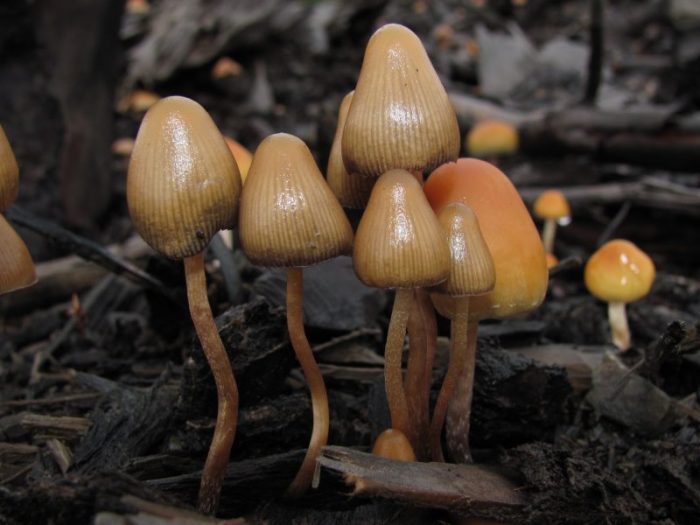
Credit: Arp via WikiCommons CC-BY SA 3.0
Several species of mushroom (called “magic mushrooms”) contain psilocybin, a powerful hallucinogenic. The mind-altering effect of psilocybin ingestion differs from individual to individual but is normally characterized by altered sensory perception and an intense emotional state. Generally, these effects are temporary and psilocybin has not been shown to be addictive or create dependencies.
Psilocybin intoxication seems to augment previously existing emotional states; i.e. if a person takes psilocybin while in an anxious state, they are likely to experience great anxiety while under the influence (called a “bad trip”). Alternatively, taking the drug while in a relaxed and content state is normally associated with elevated feelings of happiness and euphoria.
Psychedelic mushrooms have been used in religious ceremonies in various cultures throughout history. The most well known of these are the rituals performed by indigenous Mesoamerican cultures such as the Aztecs.
Magic mushrooms are also consumed recreationally for non-religious purposes. While the cultivation and sale of psilocybin-containing mushrooms is illegal in many countries, there have been recent efforts to investigate the potential therapeutic properties of psychedelic mushrooms. Preliminary research indicates that controlled dosages of psilocybin can lessen levels of stress/anxiety and contribute to greater psychological well-being.









